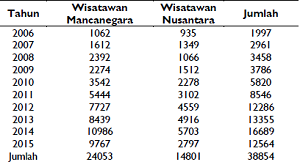Perubahan Sosial Ekonomi sebagai Dampak dari Pariwisata Taman Nasional Tanjung Puting (Studi Kasus di Kelurahan Kumai Hulu Kecamatan Kumai Kabupaten Kotawaringin Barat)
Socio-Economic Changes as The Impact of Tanjung Puting National Park Tourism (Case Study in Kumai Hulu Village, Kumai District Kotawaringin Barat Regency)
DOI:
https://doi.org/10.33084/anterior.v18i1.403Keywords:
Tourism, Social Economy, Tanjung PutingAbstract
This study aims to identify social changes that occur and map various economic benefits of the tourism potential of Tanjung Puting National Park (TNTP). For the people of Kelurahan Kumai Hulu. The benefits of this study are expected to provide information for relevant agencies for the development of TNTP tourism planning and management. There are socio-economic changes that occur to the people of Kumai Hulu, Kumai Sub-district, West Kotawaringin Regency due to the existence of TNTP tourism. Social changes are marked by the awareness of association or grouping in the Kumai community. There are two community associations, namely the Klotok Wisata Kumai Association and the Indonesian Tour Guide Association. Some values shift in the city due to tourism, before around Kumai Hulu many liquor and stall shops were young people who often gathered and drank. Where the needs and demands of tourism conditions are increasingly more significant, foreign tourists make working people start learning foreign languages, for example, Mr. Arsyad who is only a klotok worker until he becomes a guide, by self-taught with direct tourists. Aware of Kumai's public education by referring to choosing education about tourism. Some values shift in the community due to tourism, before around Kumai Hulu many liquor and stall shops were young people who often gathered and drank. Where the needs and demands of tourism conditions are increasingly higher, foreign tourists make working people start learning foreign languages.
Downloads
References
Hamsinah, B. 2016. Perencanaan dan Pengembangan Sumberdaya Terhadap Industri Pariwisata di Kabupaten Raja Ampat, Papua Barat. Inovasi: Jurnal Ilmiah Ilmu Manajemen. 3(1):97-116.
Handayani, T., Latifah, D., & Dodo. 2005. Diversity and Growth Behaviour of Nepenthes (Pitcher Plants) in Tanjung Puting National Park, Central Kalimantan Province. Biodiversitas. 6(4):248-252.
Indriani, Y., Ginoga, L.N., & Masy’ud, B. 2010. Keanekaragaman Jenis Kupu-Kupu di Beberapa Tipe Habitat di Pondok Ambung Taman Nasional Tanjung Puting Kalimantan Tengah. Media Konservasi. 15(1):1-12.
Kastolani, W. 2008. Pengembangan Wisata Terpadu Berdasarkan Daya Tarik Kawasan Konservasi di Kecamatan Cimenyan. Jurnal Geografi Gea. 8(1):1-9.
Rosita, R. 2017. Upaya Dinas Pariwisata, Kebudayaan, Pemuda dan Olahraga Kabupaten Sumenep dalam Meningkatkan Pelayanan Publik terhadap Wisatawan (Studi Kasus: Pulau Gili Labak, Kabupaten Sumenep Madura). Kebijakan dan Manajemen Publik. 5(3):1-8.
Setiawan, J. 2012. Kepariwisataan Alam Merespon Tantangan Perubahan Iklim: Studi Kasus di Taman Nasional Tanjung Putting. Jurnal Nasional Pariwisata. 4(1):1-12.
Undang-Undang Republik Indonesia Nomor 10 Tahun 2009 tentang Kepariwisataan.
Wahyono, E.H. 2013. Pesan Dari Alam. Edisi 9 Tahun VI. Pangkalan Bun: Orangutan Foundation International.

Downloads
Published
How to Cite
Issue
Section
License
All rights reserved. This publication may be reproduced, stored in a retrieval system, or transmitted in any form or by any means, electronic, mechanical, photocopying, recording.












